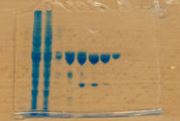They seem to dance, in impossible positions. Arranged neatly in columns and rows, Wei Ming, a postdoctoral researcher in the intracellular organisation lab led by Thomas Surrey at the Centre for Genomic Regulation (CRG), has more than 40.
They are dehydrated acrylamide gels. Before taking this shape, they had been used in the lab to run samples, as they can separate proteins by size. The samples are stained with a blue dye to make the proteins appear, and each line represents proteins of a particular molecular weight: lighter proteins are faster and end up at the bottom, while larger proteins don’t make as much progress and end up at the top.
In the @surrey_lab they study how the cytoskeleton (the cell skeleton), which shapes the cell and is essential for the separation of chromosomes during cell division, is organised and regulated. Its fundamental component is tubulin, which forms microtubules, and whose purification process can be seen in this gel:

Thank you very much, Wei Ming, for sharing your research with us through this curious and original collection of acrylamide gels!
Want to see your photo here? Send us images related to science or life in the PRBB to ellipse@prbb.org.






